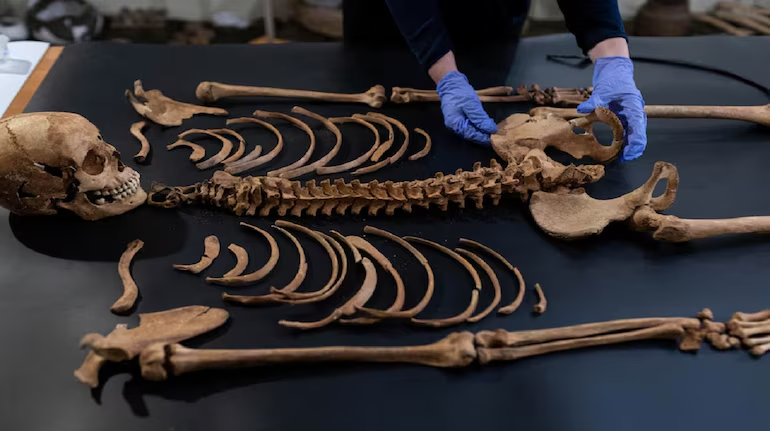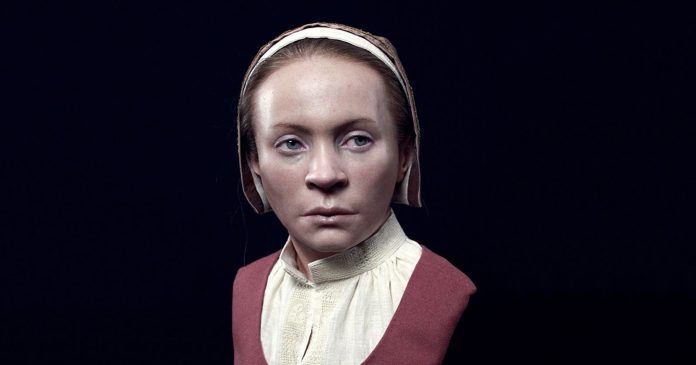The Mystery of Zosia: Unraveling the Tale of a 17th Century “Vampire” in Poland
In a field in northern Poland, a chilling discovery was made that would challenge historians and archaeologists alike. The remains of a young woman were unearthed in 2022, buried with a sickle across her neck and a padlock fastened to her left big toe. These unusual burial practices, steeped in 17th-century folklore, were designed to prevent the dead from rising—a clear sign that she was considered a threat to the living. According to the superstitions of the time, such individuals were believed to be vampires or other malevolent entities.
The identity of this woman, nicknamed “Zosia” by locals, has remained a mystery. Who was she, and why was she subjected to such a fearful and punitive burial? Researchers have been piecing together her story, uncovering clues not only about her life but also about the societal fears that led to her gruesome interment. Thanks to advances in forensic science and facial reconstruction, Zosia’s face has now been brought back to life, offering a more humanized view of someone once feared as a vampire.
The unearthing of Zosia’s grave was a pivotal moment for the team led by archaeologist Dariusz Poliński, a professor of medieval history at Nicolaus Copernicus University in Toruń, Poland. The burial site, which dates back roughly 400 years, contained more than just human remains. It was a stark reminder of the superstitions and societal fears that gripped communities during a period of turmoil in Europe.
When forensic artist Oscar Nilsson revealed his 3D reconstruction of Zosia’s face, Poliński described the experience as “mind-blowing.” For the first time, the researchers could look into the eyes of someone who had lived and died centuries ago. “It wasn’t a mask,” Poliński said, reflecting on the depth of emotion captured in the reconstruction. The face was not just a scientific achievement; it was a poignant reminder of the human being behind the vampire legend.
Oscar Nilsson, renowned for his detailed facial reconstructions, played a crucial role in giving Zosia her face. Using a 3D-printed model of her skull, Nilsson carefully applied layers of clay to recreate her features. His work was not merely technical—it was deeply emotional. “I’m used to reconstructing faces,” Nilsson said, “but in this case, I’m looking forward to giving her some human dignity back. She deserved something better.”
The reconstruction captures the youthful essence of Zosia, believed to have been between 18 and 20 years old at the time of her death. Despite the grim circumstances of her burial, her face exudes a sense of calm and resilience. For Nilsson and the research team, the project was about more than just science; it was about restoring humanity to a figure long dehumanized by fear and superstition.
While her exact cause of death remains unknown, analyses of Zosia’s remains have provided insights into her health. Researchers discovered signs of a condition that may have caused her chronic pain and fainting spells. These symptoms, linked to spinal abnormalities, could explain why she was viewed with suspicion in her community. In addition to spinal issues, Zosia’s sternum showed signs of deformity, possibly resulting in a visible chest tumor.

Though these health conditions would have caused discomfort and perhaps visible abnormalities, they were not life-threatening. The medical team continues to investigate, hoping to pinpoint the cause of her death. What is clear, however, is that her ailments likely played a role in the community’s perception of her as different or otherworldly, contributing to the belief that she was a vampire.
Despite the superstitions surrounding her, Zosia’s burial suggests she was not an ordinary individual. Fragments of delicate silk fabric and metallic threads made of silver and gold were found in her grave, likely remnants of a fine headdress or bonnet. These items indicate that she came from a wealthy or high-status background.
Further analysis of her remains revealed an even more intriguing detail: Zosia may not have been a local. Chemical isotope tests and DNA analysis suggested that she originated from southern Scandinavia, possibly Sweden. Her status as a foreigner in 17th-century Poland could have added to the suspicion and fear surrounding her.
At the time, Poland and Sweden were embroiled in a series of conflicts, and tensions between the two nations were high. Zosia’s presence in Poland during such a tumultuous period may have fueled local fears, especially in a small community already grappling with the hardships of the Little Ice Age. This period of climatic cooling led to crop failures and widespread famine, heightening societal anxieties and perhaps making communities more prone to scapegoating individuals who were perceived as different.
Zosia’s burial is a window into the 17th-century European psyche, a time when fear of the supernatural ran deep. The vampire folklore that surrounded her burial was not unique to Poland. Across Europe, similar practices were observed: corpses suspected of being vampires were often buried with objects intended to pin them down or prevent them from rising.
In Zosia’s case, the sickle placed across her neck and the padlock on her toe were symbolic measures meant to keep her confined to the grave. The sickle, a sharp farming tool, could decapitate her if she attempted to rise, while the padlock represented a permanent barrier to her reanimation. These rituals highlight the lengths to which communities would go to protect themselves from perceived supernatural threats.
Such practices stemmed from a deep-seated fear of the undead. Vampires were believed to bring death and misfortune to the living, and those suspected of vampirism were treated with extreme caution—even in death. The burial rites performed for Zosia reflect this fear, showing how folklore and superstition shaped the treatment of the dead.
The discovery and ongoing research into Zosia’s life and burial have been captured in the documentary Field of Vampires, which aired as part of PBS’s Secrets of the Dead series. The film delves into the archaeological process, the scientific methods used to reconstruct her face, and the historical context of vampire folklore.
The documentary not only brings Zosia’s story to a wider audience but also sheds light on the broader cultural and historical factors that influenced her community’s fear of vampires. Through interviews with researchers like Poliński and Nilsson, viewers gain an understanding of the human side of archaeology—the effort to connect with individuals from the past and restore their humanity.
The case of Zosia taps into a fascination with vampires that persists to this day. From folklore and literature to modern films and TV shows, vampires have captivated the human imagination for centuries. They embody a blend of fear and allure, representing both the unknown and the forbidden.
However, Zosia’s story offers a different perspective on the vampire legend. Rather than a bloodthirsty creature of the night, she was a young woman, likely misunderstood and ostracized by her community. Her burial reflects the darker side of human behavior—how fear and superstition can lead to the dehumanization of others.
As researchers continue to study her remains, Zosia’s story serves as a reminder of the complex interplay between folklore, history, and human psychology. It also highlights the importance of scientific inquiry in challenging old narratives and shedding light on the truth.
Zosia’s reconstructed face, now part of the public record, stands as a testament to the humanity behind the vampire legend. Through the work of archaeologists and forensic artists, she has been given a voice and a place in history, reminding us of the dangers of fear and the enduring power of compassion.
Her story, though rooted in the past, resonates today. It calls on us to confront our own biases and to seek understanding, even when faced with the unknown. As the research into her life continues, Zosia remains a symbol of the human spirit’s resilience and the unending quest for truth.

In the quiet rural field of Pień near Dąbrowa Chełmińsk in northern Poland, an eerie discovery from the 17th century has provided a rare glimpse into the region’s ritualistic burial practices. In 2022, archaeologists unearthed the remains of a young woman, nicknamed “Zosia” by locals, whose grave was unlike any other. Buried with a sickle across her neck and a padlock fastened to her toe, Zosia’s interment was steeped in superstitions aimed at keeping her confined to her grave. These measures reflect the fear that she, like others suspected of being revenants, might return from the dead to harm the living.
The items found in Zosia’s grave were not randomly chosen. Both the sickle and the padlock were made of iron, a material believed to offer protection against supernatural forces. Archaeologist Dariusz Poliński, who led the excavation, explained that Zosia’s burial unfolded in stages. Initially, she was laid to rest in a natural position within a coffin, her head placed on a pillow and oriented westward. A padlock, meant to “lock” her soul to the grave, was secured around her toe.
However, it seems that the initial precautions did not allay fears. At some point after her burial, the grave was reopened. According to Poliński, this decision might have been prompted by a misfortune or another unexplained death in the community, events often attributed to the restless dead. When the grave was disturbed, her spine was broken or twisted, and the effort to turn or remove her body was abandoned. Instead, a sickle was placed over her throat, a final, desperate measure to prevent her from rising as a revenant.
Based on a detailed model of her skull and genetic information extracted from her DNA, researchers have successfully reconstructed the face of a young woman buried in an unusual grave in Pień, a small village in northern Poland, dating back to the 17th century. This remarkable discovery sheds new light on a burial practice steeped in fear and superstition, offering a glimpse into the life and times of the woman, known locally as “Zosia.”
Zosia’s disturbed burial is part of a broader tradition of ritualistic practices aimed at stopping the dead from returning. According to Poliński, graves believed to hold revenants have been found across Europe, with such practices spanning multiple historical periods. The sickle, often associated with agriculture, took on a more sinister role in these burials, positioned to decapitate the deceased should they attempt to rise.
Martyn Rady, the Masaryk Professor Emeritus of Central European History at University College London, notes that revenant legends are nearly universal. “All cultures have a belief that the dead may return to bother the living,” Rady explains. Individuals suspected of becoming revenants were often those who had died violently, led tumultuous lives, or were buried without proper rites.
While revenants were feared for their ability to spread disease or misfortune, they were not necessarily synonymous with vampires as we understand them today. Rady explains that the term “vampire” emerged later, around the 1720s, when officials of the Habsburg monarchy documented local legends. These early accounts established that vampires were revenants who fed on the living and spread their affliction like a contagion. Although Zosia’s grave shares elements of these legends, she does not fit this more specific vampire archetype.
The field where Zosia was found has been the subject of archaeological interest since 2005, when researchers first began excavating the site. Used as a cemetery for roughly four generations in the 17th century, the area contains dozens of graves, with geophysical surveys indicating many more yet to be uncovered. However, no written records or maps document this burial ground, adding to its mystery.
Beyond Zosia’s grave, other burials at the site reveal similarly unusual practices. A child’s remains were found face down, with a padlock beneath the legs and the upper torso missing. Another grave contained the skeleton of a pregnant woman, with the remains of the fetus still in her womb. These findings suggest that anti-revenant measures were not isolated to Zosia alone but were part of a broader set of rituals within this community.
To better understand the connections between the individuals buried in this field, Poliński’s team is conducting DNA analyses. By comparing genetic markers, they hope to determine whether those interred here were related or belonged to distinct groups. This genetic research could provide critical insights into the community’s structure and why certain individuals, like Zosia, were singled out for such elaborate burial practices.
The research team’s findings, which will be published in a scientific journal next year, aim to shed light on the fears and beliefs that shaped the lives—and deaths—of these individuals. By reexamining previously excavated graves, they hope to identify more instances of “anti-vampiric” practices and explore their cultural significance.
The fear of the dead was not unique to this region or period. Across Europe, societies developed various strategies to neutralize the perceived threat of the restless dead. These included staking bodies to the ground, surrounding graves with thorny branches, or decapitating corpses. Such practices were deeply rooted in the belief that certain individuals, once dead, could become conduits for disease or other calamities.
Revenant graves like Zosia’s serve as a stark reminder of the anxieties that permeated early modern societies. They reflect a worldview where the boundary between life and death was porous, and the dead could wield influence over the living. These fears were particularly pronounced during times of crisis, such as the Little Ice Age, when famine and disease were rampant.
Despite the macabre nature of her burial, Zosia’s story offers a profound opportunity to understand the human side of these ancient fears. Through the work of archaeologists and forensic scientists, her identity is being reconstructed, piece by piece. Facial reconstructions, like the one created by Oscar Nilsson, have allowed us to see Zosia not just as a revenant or a figure of folklore but as a young woman who lived a complex life in a tumultuous time.
For Nilsson, the goal of his reconstruction was to restore Zosia’s dignity, giving her back the humanity that fear had stripped away. His detailed work captures not only her physical features but also the emotional weight of her story, bridging the gap between past and present.

As research continues, Zosia’s grave remains a focal point for understanding the rituals and beliefs of her time. Her story, preserved through modern archaeology and historical analysis, challenges us to confront our own fears and prejudices. By studying the past, we gain a clearer understanding of how societies have historically managed uncertainty and fear, often through ritual and symbolism.
Zosia’s tale is more than a historical curiosity; it is a testament to the enduring human struggle to make sense of life, death, and the unknown. Her burial, marked by fear and superstition, speaks volumes about the cultural context of 17th-century Poland. Through ongoing research, her story continues to unfold, offering new insights into the rituals and beliefs that shaped her world.
Zosia’s legacy serves as a poignant reminder of our shared humanity, even across centuries. In studying her life and death, we honor her memory and deepen our understanding of the fears that once governed the lives of those who came before us.




